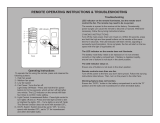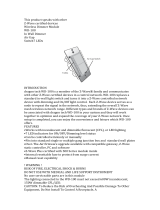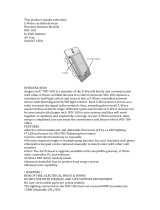Savant WIS-SWS102-00 Reference guide
- Category
- Dimmers
- Type
- Reference guide
This manual is also suitable for

Metropolitan Wireless Keypads and Dimmers 4 of 4 Copyright © 2018 Savant Systems, LLC
009-1436-04 | 181212
Multi-Gang Installations
When combining multiple keypads into a multi-ganged box, derating is required per table below. Remove the outside tabs from one
or both sides of each device so they all fi t into the electrical switch box. Below are examples of 2, 3 and 4-gang scenarios.
– Tabs are removed from both sides of the inside gang devices.
– Tabs are NOT removed from outside edges of the devices at the end of each gang.
Derating Table
Device Load Type 1-Gang 2-Gang 3-Gang 4-Gang
Adaptive Dimmer
Incandescent 600W 550W 500W 500W
CFL/LED 150W 150W 150W 150W
Magnetic Low Voltage 600VA (450W) 550VA (400W) 500VA (375W) 500VA (375W)
Electronic Low Voltage 450W 400W 375W 375W
Wiring Diagrams
The diagrams below display how to wire the Metropolitan style keypad. Any unused wires must have the bare wire portion (stripped
end) cut o and the wire must be capped with a wire nut.
Single Dimmer Installation Example No Neutral Dimmer Installation Example
WARNINGS:
– Using the dimmer in a No Neutral confi guration with loads other than incandescent is not supported.
– In a No Neutral confi guration, if the type of load installed is not supported by the dimmer, the dimmer will not supply power
to the load and the six dimmer LEDs on the front of the dimmer will blink rapidly.
From
Power
Cap if
Unused
FROM
POWER
Black
Tape
Black
Tape
Cap if
Unused
UP
120V 60Hz
UP
120V 60Hz
UP
UP
UP
120V 60Hz 120V 60Hz 120V 60Hz
UP
120V 60Hz
UP
UP
UP
120V 60Hz 120V 60Hz 120V 60Hz
Metropolitan Wireless Keypads and Dimmers 1 of 4 Copyright © 2018 Savant Systems, LLC
009-1436-04 | 181212
Metropolitan Wireless Keypads and Dimmers
Quick Reference Guide
The Metropolitan wireless keypads and Dimmers are specifi cally designed to function within a Savant Control system to switch
most lighting loads. This includes incandescent, magnetic and electronic low voltage, dimmable CFL, and dimmable LED lamps.
The Savant wireless keypads replace any standard 120V AC light switch or dimmer and can be wired into either a standard or
no neutral confi guration. With the addition of the Savant Auxiliary Control, these keypads can accommodate most 3-way wiring
designs for multi-location control.
Finally, these Keypads and Dimmers utilizes the local 802.11 b/g/n wireless network to allow it to be added to the Savant Pro System
for complete control of lighting as well as other switching and dimming functions.
Products
Adaptive Dimming
Metropolitan Wireless Keypad (WIK-xxx104)
Metropolitan Wireless Dimmer (WID-xxx102)
Box Contents
(1) Keypad/Dimmer without faceplate
(2) Mounting Screws
(5) Wire Nuts
(1) Quick Reference Guide (this document)
Environmental
Temperature 32° to 104° F (0° to 40° C)
Humidity
10% to 90% Relative Humidity
(non-condensing)
Location Indoor Use Only
Pollution Degree 2
Specifi cations
Dimensions
Height 4.13in (10.49cm) Shipping 7.0in (17.78cm)
Width 2.38in (6.05cm) Shipping 4.5in (11.43cm)
Depth 2.08in (5.28cm) Shipping 3.0in (7.62cm)
Weight Shipping 0.60lb (0.272kg)
Recommended Back Box Depth
All Metropolitan Dimmers and switches require a standard U.S.
electrical back box.
– Recommended - 3.5 in (8.89 cm) deep
– Minimum 2.25 in (5.72 cm) deep
– Type 1 enclosure for control
Power
Input 120V AC at 60 Hz
Power:
Load (Max)
600W 5A @ 120V AC (See Derating Table)
Supported Load Types
Standard
Confi guration
Incandescent, Electronic/Magnetic Low
Voltage, Dimmable CFL, Dimmable LED
No Neutral
Confi guration
Incandescent only
(minimum load = 25Watts)
Standards
Wireless 802.11 b/g/n 2.4 GHz (only)
Security WPA™, WPA2™, WPA1™ +WPA2™, WEP
Regulatory
Safety and
Emissions
FCC Part 15 | UL
For more details, see the Regulatory and
Safety insert.
Contains FCC
ID:
TLZ-CU277B
Contains IC: 6100A-CU277B
RoHS Compliant
Minimum Supported Release
da Vinci Blueprint 8.2
WARNING! Using a keypad in No Neutral confi guration
with loads other than incandescent is not supported.
Installation
Operating
Control
Type 1.B action
Software Class A
Additional Documentation
Installation and Calibration (009-1459-xx)
Programming Guide (009-1461-xx)
Provisioning Guide (009-1460-xx)
Front Assembly Conversion (009-1376-xx)
For Product Info

Metropolitan Wireless Keypads and Dimmers 2 of 4 Copyright © 2018 Savant Systems, LLC
009-1436-04 | 181212
Hardware Overview
Front Panel
A
Ambient Light Sensor - Detects the level of ambient light in the room and adjusts the LED brightness on the front panel. The
ambient light sensor operation is modifi ed using RacePoint Blueprint®.
B
Dimming Level - Six indicator LEDs track the brightness of the load. LEDs turn on from left to right as intensity on load
increases and turns o from right to left as intensity decreases. Once confi gured in Blueprint, the LEDs track the brightness of
the scene created.
C
RESET Button – The reset button has two functions:
– Press and Hold (hold for 5 seconds) – Resets keypad to AP Mode
– After fi ve seconds, all LEDs on the front panel illuminate, remain on for two seconds, and then fl ash twice. The keypad
reboots and reverts to Access Point Provisioning Mode (AP Mode). In this mode, the two top button LEDs blink in an
alternating pattern. The keypad is now ready to be provisioned. Refer to the Metropolitan Style Wireless Lighting –
Provisioning guide on how to provision the keypad.
– Press and Release – Calibrates keypad.
– After releasing, all LEDs illuminate for about six seconds and then fl ash twice.
– The load characteristics are checked to determine the best phase for the attached load.
– The control parameters for the no neutral operation, if applicable, are determined.
HELPFUL INFORMATION!! (For Press and Release)
– After the calibration is complete, the keypad resets and the button LEDs will blink a specifi c pattern. The pattern
indicates if the keypad was previously connected to a wireless network. Refer to the table in the Electrician Removal/
Installation section below for the states the keypad could be in after a reset.
D
Switch LED - LED lights when button is pressed. LEDs are also used to indicate the state of the switch when connecting
switch to a network. Refer to the LED Sequencing table. Once confi gured in Blueprint, the Switch LED shows the scene state.
E
Service Switch - The service switch disconnects power from the load (red wire). Toggle the service switch to O whenever
changing the load. The service switch can also be used to power cycle the dimmer.
F
Green
Ground - Wire to Gnd.
G
White
Neutral - Return path for voltage.
H
Yellow
Traveler - Wire to one or more Auxiliary Controls for multi-location control.
I
Red
Load -Wire to the load.
J
Black
Line - Wire to hot from AC power source.
WIK-xxx105 WID-xxx102
Device wires are all a fi ve inch #16 AWG stranded wire.
LEDs blink in an
alternating pattern
Keypad is in AP Mode and needs to be provisioned. After a short time (up to one minute), the
blinking will stop. In this state, the keypad is still in AP Mode. The blinking stopped intentionally
for cases where the device is not provisioned onto the network and can be used as a manual
control till provisioned.
Left Button LED: solid
Right Button LED: blinks
Keypad is connected to the local network (IP Address assigned) but not bound to the Host/
Controller. After a short time (up to one minute), the blinking will stop. Although the blinking has
stopped, the keypad remains in this state until the binding process is complete.
Both top Button LEDs
blink in sync
If the IP settings are incorrect, the keypad tries to establish a connection with the local network.
After a short time (up to one minute) the blinking will stop. Although the blinking has stopped,
the keypad remains in this state until it is reset to its default values and then provisioned with the
correct network settings.
All Dimming LEDs blink Indicates the type of load connected is not supported. Try toggling service switch to recalibrate.
LED Sequencing
UP
120V 60Hz
E
D
C
B
A
UP
120V 60Hz
A B
C
D
E
F G H I J
Rear Panel
Metropolitan Wireless Keypads and Dimmers 3 of 4 Copyright © 2018 Savant Systems, LLC
009-1436-04 | 181212
Electrician Removal/Installation
ELECTRIC SHOCK! The 120V AC, 60 Hz source power poses an electrical shock hazard that has the potential to cause serious
injury to installers and end users.
IMPORTANT NOTES!
– A licensed electrician is required to install any of the Metropolitan wireless lighting devices. Isolate and turn o power at the
main breaker panel prior to installing any electrical devices.
– For supply, neutral, and ground connections use only #14 AWG or larger solid copper wires (80°C) with insulation stripped
to ⅝ in (16 mm).
1. From the main electrical panel, switch o the breaker supplying power to the circuit.
2. Unscrew and remove the wall plate (if applicable).
3. Verify power is removed using a 120V AC tester.
4. Unscrew the two 6-32 fl at head screws and remove the existing toggle/rocker switch or analog dimmer (if applicable).
5. Disconnect wires and remove the device. It is good practice to label each wire as it is removed. If not already identifi ed, mark
each wire to ensure proper rewiring, especially if the circuit employs a 3-way confi guration.
6. Connect the in-wall wires to the leads coming from the Metropolitan style device using the supplied wire nuts or an approved
alternative. Refer to the Wiring Diagrams section for di erent diagram setups.
7. Insert the new device (dimmer, switch, keypad, etc.) into the electrical switch box and secure using the 6-32 fl at head screws
provided. DO NOT use a powered screw driver. A powered screwdriver can over tighten the screws.
8. Install the front faceplate wall plate adapter. Toggle the Service
Switch to the O position.
9. Switch power at the breaker to On and toggle the Service Switch
to power-on the keypad. The keypad will go through a diagnostic
sequence and calibrate itself to the type of load connected. The
LEDs will blink as follows
– All LEDs illuminate bright and then blink twice.
– The load will switch On for a few seconds and then switch O .
In some instances, the load may switch On again and gradually
dim up to full brightness to further refi ne the calibration
process.
– Next, the top two button LEDs blink a specifi c pattern. The
pattern indicates the state of the keypad. The patterns and
state of the keypad are described in the next table
NOTE: Install the wall adapter to cover the metal yoke prior to
applying power. If replacing a Echo style device, remove
power before removing the wall plate adapter
10. Verify the keypad is calibrated and working correctly, press the rotary dial and the load connected to the red wire will switch On.
Turn the dial clockwise to increase the brightness of the load and turn counterclockwise to decrease the brightness of the load.
Press the dial again to switch the load O .
Wall Plate and Adapter sold separately
Wall Plate
Adapter
Wall Plate
Mounting
Screws
Electrical
Switch Box
Swapping a Load (Bulb)
If a load needs to be changed, the keypad will need to be recalibrated to the new load. To change a load, do the following:
1. Toggle the Service Switch O .
2. Change the load (bulb).
3. Toggle Service Switch back On. The keypad will go through the diagnostics and the LED sequence described earlier in step 9.
Once complete, verify the keypad is calibrated and working correctly. See step 10 above.
Regulatory
The following statements are applicable to the Metropolitan Wireless Dimmers, Switches, Keypads, and Fan Controllers.
FCC Regulations
15.19. These devices comply with part 15 of the FCC Rules. Operation is subject to the following two conditions: (1) These devices
may not cause harmful interference, and (2) these devices must accept any interference received, including interferences that may
cause undesired operation. 15.21. The changes or modifi cations not expressly approved by the party responsible for compliance
could void the user’s authority to operate the equipment. 15.105. This equipment has been tested and found to comply with the
limits for CLASS B digital device, pursuant to Part 15 of FCC Rules. These limits are designed to provide reasonable protection
against harmful interference when the equipment is operated in a residential environment. This equipment generates, uses and can
radiate radio frequency energy and, if not installed and used in accordance with the instructions, may cause harmful interference to
radio communications, However there is no guarantee that interference will not occur in a particular installation, If this equipment
does cause harmful interference to radio or television reception, which can be determined by turning the equipment o and on, the
user is encouraged to try to correct the interference by one or more of the following measures:
– Reorient or relocate the receiving circuit di erent from that to which receiver is connected.
– Increase the separation between the equipment and the receiver.
– Consult the dealer or experienced radio/TV technician for help.
IC Regulations:
RSS-Gen 7.1.3. These devices comply with Industry Canada license-exempt RSS standard(s). Operation is subject to the following
two conditions: (1) These devices may not cause interference, and (2) These devices must accept any interference, including
interference that may cause undesired operation of the device. RSS-21- Annexe 9: A 9.4. Le présent appareil est conforme aux CNR
d’Industrie Canada applicables aux appareils radio exempts de licence. L’exploitation est autorisée aux deux conditions suivantes:
(1) l’appareil ne doit pas produire de brouillage, et (2) l’utilisateur de l’appareil doit accepter tout brouillage radioélectrique subi,
même si le brouillage est susceptible d’en compromettre le fonctionnement.
-
 1
1
-
 2
2
Savant WIS-SWS102-00 Reference guide
- Category
- Dimmers
- Type
- Reference guide
- This manual is also suitable for
Ask a question and I''ll find the answer in the document
Finding information in a document is now easier with AI
Related papers
-
Savant WIS-LAS102-00 Reference guide
-
Savant WIK-BKCONV-00 Reference guide
-
Savant WPD-LAT102-00 Reference guide
-
Savant WIK-BKCONV-00 Reference guide
-
Savant WID-BKCONV-00 Reference guide
-
Savant WPS-BKS102-00 Reference guide
-
Savant SKL-1010-00 Reference guide
-
Savant WIK-BKA105-00 Reference guide
-
Savant WIF-BKCONV-00 Reference guide
-
Savant WI3-SWS102-00 Reference guide
Other documents
-
 Honeywell Ceiling Fans 50195 User guide
Honeywell Ceiling Fans 50195 User guide
-
LEEDARSON HSA11FWB User manual
-
 Dragon Tech WD-100 User manual
Dragon Tech WD-100 User manual
-
LEEDARSON LIGHTING HDA11FWB User manual
-
 TREATLIFE Smart Dimmer Switch,Neutral Wire Required,Treatlife WiFi Light Switch for Dimmable LED, Halogen and Incandescent Bulbs, Compatible User manual
TREATLIFE Smart Dimmer Switch,Neutral Wire Required,Treatlife WiFi Light Switch for Dimmable LED, Halogen and Incandescent Bulbs, Compatible User manual
-
 Dragon Tech WD-100 User manual
Dragon Tech WD-100 User manual
-
Johnson Controls PD700 Installation guide
-
click GridPro User manual
-
Control4 EU 2-Way Lighting User guide
-
Nexa CMR-101 Owner's manual





